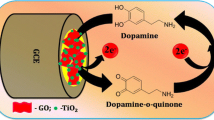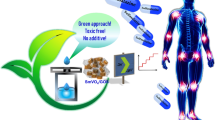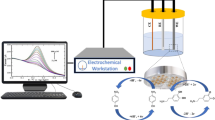Abstract
This research introduces a novel electrochemical sensor designed for the detection of chloroquine. The sensor was developed via a simple method to synthesize TiO2 nanoparticles on reduced graphene oxide. The modified electrodes created in this manner exhibited high electrocatalytic activity and distinct chemical reactivity. Various techniques were utilized to perform morphological characterization of the nanocomposites. These techniques revealed alterations revealed changes in functional groups and the attachment of titanium to the reduced graphene oxide present on the electrode surface, thereby elucidating the reasons for the enhanced electrochemical performance. The sensor had a broad measurement range for chloroquine, capable of detecting concentrations as low as 10−8 M. It is applicable for diverse sample analyses, including water, pharmaceuticals, human urine, and serum, with satisfaction ranging between 97 and 99%.
Graphical Abstract
The development strategy. An electrochemical sensor was developed using titanium oxide nanoparticles attached to reduced graphene oxide TiO2-NPs @RGO/GCE for real-time detection of chloroquine in real contaminated samples such as human urine, human serum, and tap water with low detection limit.











Similar content being viewed by others
References
Thapliyal N, Chiwunze TE, Karpoormath R et al (2016) Research progress in electroanalytical techniques for determination of antimalarial drugs in pharmaceutical and biological samples. RSC Adv 6:57580–57602. https://doi.org/10.1039/C6RA05025E
Weingarten HL, Cherry EJ (1981) A chloroquine fatality. Clin Toxicol 18:959–963. https://doi.org/10.3109/15563658108990324
Rainsford KD, Parke AL, Clifford-Rashotte M, Kean WF (2015) Therapy and pharmacological properties of hydroxychloroquine and chloroquine in treatment of systemic lupus erythematosus, rheumatoid arthritis and related diseases. Inflammopharmacol 23:231–269. https://doi.org/10.1007/s10787-015-0239-y
Touret F, de Lamballerie X (2020) Of chloroquine and COVID-19. Antiviral Res 177:104762. https://doi.org/10.1016/j.antiviral.2020.104762
Savarino A, Di Trani L, Donatelli I et al (2006) New insights into the antiviral effects of chloroquine. Lancet Infect Dis 6:67–69. https://doi.org/10.1016/S1473-3099(06)70361-9
Sotelo J, Briceño E, López-González MA (2006) Adding chloroquine to conventional treatment for glioblastoma multiforme: a randomized, double-blind, placebo-controlled trial. Ann Intern Med 144:337. https://doi.org/10.7326/0003-4819-144-5-200603070-00008
Yao X, Ye F, Zhang M et al (2020) In vitro antiviral activity and projection of optimized dosing design of hydroxychloroquine for the treatment of severe acute respiratory syndrome coronavirus 2 (SARS-CoV-2). Clin Infect Dis 71:732–739. https://doi.org/10.1093/cid/ciaa237
Glasco DL, Mamaril AM, Sheelam A et al (2022) Selective detection of chloroquine in human urine with application at the point-of-care. J Electrochem Soc 169:077513. https://doi.org/10.1149/1945-7111/ac80d7
Lynch JB, Davitkov P, Anderson DJ et al (2020) Infectious Diseases Society of America Guidelines on infection prevention for healthcare personnel caring for patients with suspected or known coronavirus disease 2019. Clin Infect Dis ciaa1063. https://doi.org/10.1093/cid/ciaa1063
Goodman JL, Borio L (2020) Finding effective treatments for COVID-19: scientific integrity and public confidence in a time of crisis. JAMA 323:1899. https://doi.org/10.1001/jama.2020.6434
Bodur S, Erarpat S, Günkara ÖT, Bakırdere S (2021) Development of an easy and rapid analytical method for the extraction and preconcentration of chloroquine phosphate from human biofluids prior to GC–MS analysis. J Pharmacol Toxicol Methods 108:106949. https://doi.org/10.1016/j.vascn.2021.106949
Nagib Qarah AS, Basavaiah K, Swamy N (2017) Sensitive and selective extraction-free spectrophotometric assay of chloroquine phosphate in pharmaceuticals based on ion-pair reaction with bromocresol green and bromocresol purple. Pharm Anal Acta 8:2
Ducharme J, Farinotti R (1997) Rapid and simple method to determine chloroquine and its desethylated metabolites in human microsomes by high-performance liquid chromatography with fluorescence detection. J Chromatogr B Biomed Sci Appl 698:243–250. https://doi.org/10.1016/S0378-4347(97)00273-9
Croes K, McCarthy PT, Flanagan RJ (1994) Simple and rapid HPLC of Quinine, hydroxychloroquine, chloroquine, and desethylchloroquine in serum, whole blood, and filter paper-adsorbed dry blood. J Anal Toxicol 18:255–260. https://doi.org/10.1093/jat/18.5.255
Papadopoulos K, Triantis T, Dimotikali D, Nikokavouras J (2000) Radiostorage- and photostoragechemiluminescence: analytical prospects. Anal Chim Acta 423:239–245. https://doi.org/10.1016/S0003-2670(00)01118-1
Mashhadizadeh MH, Akbarian M (2009) Voltammetric determination of some anti-malarial drugs using a carbon paste electrode modified with Cu(OH)2 nano-wire. Talanta 78:1440–1445. https://doi.org/10.1016/j.talanta.2009.02.040
Srivastava M, Tiwari P, Mall VK et al (2019) Voltammetric determination of the antimalarial drug chloroquine using a glassy carbon electrode modified with reduced graphene oxide on WS2 quantum dots. Microchim Acta 186:415. https://doi.org/10.1007/s00604-019-3525-3
Zoubir J, Bougdour N, Radaa C et al (2022) Elaboration of a novel nanosensor using nanoparticles of α-Fe2O3 magnetic cores for the detection of metronidazole drug. Urine human and tap water. Sens Int 3:100160
Zoubir J, Elkhotfi Y, Radaa C et al (2021) Electrocatalytic detection of dimetridazole using an electrochemical sensor Ag@ CPE. Analytical application. Milk, tomato juice and human urine. Sens Int 2:100105
Zhao X, Zhang P, Chen Y et al (2015) Recent advances in the fabrication and structure-specific applications of graphene-based inorganic hybrid membranes. Nanoscale 7:5080–5093. https://doi.org/10.1039/C5NR00084J
Jiao L, Zhang L, Wang X et al (2009) Narrow graphene nanoribbons from carbon nanotubes. Nature 458:877–880. https://doi.org/10.1038/nature07919
Zhang P, Lu X, Huang Y et al (2015) MoS2 nanosheets decorated with gold nanoparticles for rechargeable Li–O2 batteries. J Mater Chem A 3:14562–14566. https://doi.org/10.1039/C5TA02945G
Kim KS, Zhao Y, Jang H et al (2009) Large-scale pattern growth of graphene films for stretchable transparent electrodes. Nature 457:706–710
Zhu S, Wang J, Fan W (2015) Graphene-based catalysis for biomass conversion. Catal Sci Technol 5:3845–3858. https://doi.org/10.1039/C5CY00339C
Castro Neto AH, Guinea F, Peres NMR et al (2009) The electronic properties of graphene. Rev Mod Phys 81:109–162. https://doi.org/10.1103/RevModPhys.81.109
Zoubir J, Bakas I, Qourzal S et al (2023) Electrochemical sensor based on a ZnO-doped graphitized carbon for the electrocatalytic detection of the antibiotic hydroxychloroquine. Application: tap water and human urine. J Appl Electrochem. https://doi.org/10.1007/s10800-022-01835-2
Zoubir J, Radaa C, Qourzal S et al (2023) Design of a new electrochemical sensor of iron III oxide nanoparticles decorated with carbon graphite for the detection of traces of nitrofurazone an antibiotic drug. application: Tap Water and Well Water. SSRN J. https://doi.org/10.2139/ssrn.4334695
Li Y, Cai Q, Wang L et al (2016) Mesoporous TiO 2 nanocrystals/graphene as an efficient sulfur host material for high-performance lithium–sulfur batteries. ACS Appl Mater Interfaces 8:23784–23792. https://doi.org/10.1021/acsami.6b09479
Liu Y, Liu J, Bin D et al (2018) Ultrasmall TiO 2 -coated reduced graphene oxide composite as a high-rate and long-cycle-life anode material for sodium-ion batteries. ACS Appl Mater Interfaces 10:14818–14826. https://doi.org/10.1021/acsami.8b03722
Cheng G, Akhtar MS, Yang O-B, Stadler FJ (2013) Novel Preparation of anatase TiO 2 @reduced graphene oxide hybrids for high-performance dye-sensitized solar cells. ACS Appl Mater Interfaces 5:6635–6642. https://doi.org/10.1021/am4013374
Hong Z, Zhou K, Zhang J et al (2016) Self-assembled synthesis of mesocrystalline TiO 2 @C-rGO hybrid nanostructures for highly reversible sodium storage. Cryst Growth Des 16:6605–6612. https://doi.org/10.1021/acs.cgd.6b01293
Fang D, Pan M, Yi H et al (2019) Enhanced electrochemiluminescence of luminol-DBAE system based on self-assembled mesocrystalline hybrid for the detection of ovarian cancer marker. Sens Actuators B Chem 286:608–615. https://doi.org/10.1016/j.snb.2019.01.151
Chen M, Su H, Mao L et al (2018) Highly sensitive electrochemical DNA sensor based on the use of three-dimensional nitrogen-doped graphene. Microchim Acta 185:51. https://doi.org/10.1007/s00604-017-2588-2
**ng L, Ma Z (2016) A glassy carbon electrode modified with a nanocomposite consisting of MoS2 and reduced graphene oxide for electrochemical simultaneous determination of ascorbic acid, dopamine, and uric acid. Microchim Acta 183:257–263. https://doi.org/10.1007/s00604-015-1648-8
Dadkhah S, Ziaei E, Mehdinia A et al (2016) A glassy carbon electrode modified with amino-functionalized graphene oxide and molecularly imprinted polymer for electrochemical sensing of bisphenol A. Microchim Acta 183:1933–1941. https://doi.org/10.1007/s00604-016-1824-5
Bukkitgar SD, Shetti NP (2018) Electrochemical behavior of theophylline at methylene blue dye modified electrode and its analytical application. Materials Today: Proceedings 5:21474–21481. https://doi.org/10.1016/j.matpr.2018.06.557
Zoubir J, Radaa C, Bakas I et al (2023) One-shot synthesis of a nickel oxide/carbon composite electrocatalyst for a sensor capable of electrochemically detecting the antibiotic chloramphenicol in real samples. Carbon Lett. https://doi.org/10.1007/s42823-022-00458-z
Zoubir J, Bakas I, Assabbane A (2021) A simple platform for the electro-catalytic detection of the dimetridazole using an electrochemical sensor fabricated by electro-deposition of Ag on carbon graphite: application: orange juice, tomato juice and tap water. Heliyon 7:e07542. https://doi.org/10.1016/j.heliyon.2021.e07542
Hummers WS, Offeman RE (1958) Preparation of graphitic oxide. J Am Chem Soc 80:1339–1339. https://doi.org/10.1021/ja01539a017
Veera Manohara Reddy Y, Bathinapatla S, Łuczak T et al (2018) An ultra-sensitive electrochemical sensor for the detection of acetaminophen in the presence of etilefrine using bimetallic Pd–Ag/reduced graphene oxide nanocomposites. New J Chem 42:3137–3146. https://doi.org/10.1039/C7NJ04775D
Sravani B, Chandrashekar Y, Sri Chandana P et al (2020) Bimetallic PtCu-decorated reduced graphene oxide (RGO)-TiO2 nanocomposite for efficient oxygen reduction reaction. Synth Met 266:116433. https://doi.org/10.1016/j.synthmet.2020.116433
Zoubir J, Bakas I, Assabbane A (2021) Synthesis of ZnO nanoparticles on carbon graphite and its application as a highly efficient electrochemical nano-sensor for the detection of amoxicillin:analytical application: milk, human urine, and tap water. Nanotechnol Environ Eng 6:54. https://doi.org/10.1007/s41204-021-00146-9
Jallal Z, Radaa C, Bougdour N et al (2021) Electro-detection of the antibacterial metronidazole using zinc oxide nanoparticles formed on graphitic carbon sheets. Analytical application: Human serum and urine. Mater Sci Energy Technol 4:177–188. https://doi.org/10.1016/j.mset.2021.06.001
Mao A, Li H, ** D et al (2015) Fabrication of electrochemical sensor for paracetamol based on multi-walled carbon nanotubes and chitosan–copper complex by self-assembly technique. Talanta 144:252–257. https://doi.org/10.1016/j.talanta.2015.06.020
Pastrana-Martínez LM, Morales-Torres S, Likodimos V et al (2012) Advanced nanostructured photocatalysts based on reduced graphene oxide–TiO2 composites for degradation of diphenhydramine pharmaceutical and methyl orange dye. Appl Catal B 123–124:241–256. https://doi.org/10.1016/j.apcatb.2012.04.045
Nurdiansah H, Firlyana RE, Susanti D, Purwaningsih H (2020) Synthesis of ZnO/rGO/TiO 2 composite and its photocatalytic activity for rhodamine B degradation. IOP Conf Ser Mater Sci Eng 833:012028. https://doi.org/10.1088/1757-899X/833/1/012028
Ziarati Saravani A, Nadimi M, Aroon MA, Ebrahimian Pirbazari A (2019) Magnetic TiO2/NiFe2O4/reduced graphene oxide nanocomposite as a recyclable photocatalyst for photocatalytic removal of methylene blue under visible light. J Alloy Compd 803:291–306. https://doi.org/10.1016/j.jallcom.2019.06.245
Kocijan M, Ćurković L, Gonçalves G, Podlogar M (2022) The potential of rGO@TiO2 photocatalyst for the degradation of organic pollutants in water. Sustainability 14:12703. https://doi.org/10.3390/su141912703
Sun N, Ma J, Wang C et al (2018) A facile and efficient method to directly synthesize TiO2/rGO with enhanced photocatalytic performance. Superlattices Microstruct 121:1–8. https://doi.org/10.1016/j.spmi.2018.07.017
Benjwal P, Kumar M, Chamoli P, Kar KK (2015) Enhanced photocatalytic degradation of methylene blue and adsorption of arsenic( III ) by reduced graphene oxide (rGO)–metal oxide (TiO 2 /Fe 3 O 4) based nanocomposites. RSC Adv 5:73249–73260. https://doi.org/10.1039/C5RA13689J
Zhang H, Wang X, Li N et al (2018) Synthesis and characterization of TiO 2 /graphene oxide nanocomposites for photoreduction of heavy metal ions in reverse osmosis concentrate. RSC Adv 8:34241–34251. https://doi.org/10.1039/C8RA06681G
Hidayat R, Wahyuningsih S, Fadillah G (2022) Green synthesis approach to produce TiO2/rGO nanocomposite as voltammetric sensor for monitoring trace level bisphenol-A. Mater Sci Eng B 286:116083. https://doi.org/10.1016/j.mseb.2022.116083
Veera Manohara Reddy Y, Sravani B, Łuczak T et al (2021) An ultra-sensitive rifampicin electrochemical sensor based on titanium nanoparticles (TiO2) anchored reduced graphene oxide modified glassy carbon electrode. Colloids Surf, A 608:125533. https://doi.org/10.1016/j.colsurfa.2020.125533
Brunauer S, Emmett PH, Teller E (1938) Adsorption of gases in multimolecular layers. J Am Chem Soc 60:309–319. https://doi.org/10.1021/ja01269a023
Zhang H, Cheng L, Shang H et al (2021) A novel electrochemical sensor based on reduced graphene oxide–TiO2 nanocomposites with high selectivity for the determination of hydroxychloroquine. Russ J Electrochem 57:872–884. https://doi.org/10.1134/S1023193521080152
Oliveira GG, Azzi DC, Silva TA et al (2020) Sensitive Voltammetric detection of chloroquine drug by applying a boron-doped diamond electrode. C 6:75. https://doi.org/10.3390/c6040075
Radi A (2004) Accumulation and trace measurement of chloroquine drug at DNA-modified carbon paste electrode. Talanta. https://doi.org/10.1016/j.talanta.2004.05.024
Author information
Authors and Affiliations
Corresponding authors
Ethics declarations
Competing interests
The authors declare no competing interests.
Additional information
Publisher's Note
Springer Nature remains neutral with regard to jurisdictional claims in published maps and institutional affiliations.
Highlights
• The successful immobilization of TiO2 on rGO is done by one-pot hydrothermal treatment.
• The rGO had a high degree of reduction with the anatase structure of TiO2.
• The electrocatalytic activity of TiO2/rGO going to chloroquine is higher than that of rGO.
• The interaction between TiO2 and rGO has an important role in enhancing the recognition effect of QC.
• TiO2-NPs @RGO/GCE was used to quantify chloroquine in human urine and serum.
Supplementary Information
Below is the link to the electronic supplementary material.
Rights and permissions
Springer Nature or its licensor (e.g. a society or other partner) holds exclusive rights to this article under a publishing agreement with the author(s) or other rightsholder(s); author self-archiving of the accepted manuscript version of this article is solely governed by the terms of such publishing agreement and applicable law.
About this article
Cite this article
Zoubir, J., Daoudi, W., Assabbane, A. et al. Enhanced in situ electrochemical sensing of trace chloroquine in human urine and serum samples using highly charged TiO2-NPs decorated with reduced graphene oxide. J Solid State Electrochem 28, 2575–2591 (2024). https://doi.org/10.1007/s10008-024-05817-6
Received:
Revised:
Accepted:
Published:
Issue Date:
DOI: https://doi.org/10.1007/s10008-024-05817-6




